It is known to all, even to those without a deep knowledge of art history, for being the only signed among the known works by Caravaggio (Michelangelo Merisi; Milan, 1571 - Porto Ercole, 1610), as well as the largest: it is the Beheading of St. John the Baptist, a 1608 masterpiece preserved in the Co-Cathedral of St. John in Valletta, capital of Malta. And it is a work signed literally in blood: that which flows from the neck of the Baptist, by now lying lifeless on the ground, as one of Salome’s thugs is finishing detaching the head from the body, holding the saint on the ground, by his hair. Caravaggio signs himself “f. Michelang[e]lo,” where the dotted “f” (standing for “fra’”) indicates his status at the time the painting was executed: the Lombard artist had in fact been made a Knight of Malta on July 14, 1608 (“fra’” was the apposition by which knights were named), and to be exact Knight of Magisterial Obedience, the highest rank to which Caravaggio could inspire, since the highest orders, those of Grace and Justice, were reserved only for the nobility, to which the painter did not belong.
Caravaggio was, at the time, a man on the run, as is well known: in Rome, on May 28, 1606, the artist had killed his rival as well as creditor Ranuccio Tomassoni during a brawl, and probably on the same day, for fear of the consequences, he left the capital of the Papal States, so that already on May 31 he was in the Colonna fiefs (which stretched between a number of localities on the outskirts of Rome: Palestrina, Paliano, Zagarolo), where he stayed for three months before moving to Naples. Meanwhile, on June 28, Caravaggio was sentenced in absentia to the death penalty on charges of murder. Another eight months elapsed from his arrival in Naples, following which, in June 1607, the painter also left the Neapolitan city and moved to Malta, where he is registered from July 14, 1607. We are not sure why Caravaggio had decided to go to the island, which, since 1522, had been ruled by the Order of the Knights of St. John, who had moved there after the Turks, having besieged their former seat, namely the island of Rhodes, had taken possession of it, driving out the knights, who were therefore granted the Mediterranean island, where they founded their monastic state. Several hypotheses have been examined to understand the reasons for the painter’s move: the first, concerns a possible attempt to get back into the good graces of the pope (who had a deep respect for the Knights of Malta) precisely through the eventual obtaining of the knighthood, which would have rehabilitated him in the eyes of the pontiff. It is then possible that it was simply a job opportunity, since the powerful Grand Master of the Knights of Malta, the Frenchman Alof de Wignacourt (Flanders, 1547 - Valletta, 1622) was looking for a painter, and it is likely that Michelangelo Merisi could enjoy the intercession of Costanza Colonna, who knew both the Grand Master and the artist. So much so that Caravaggio’s first work in Malta was precisely a portrait of the Grand Master. Or, although it seems less likely, Merisi hoped to obtain the same title of knight that two of his most hated enemies, Giovanni Baglione and Giuseppe Cesari known as the Cavalier d’Arpino, already possessed. More recent hypotheses tend instead to consider a possible Neapolitan intermediary.
In any case, whatever the reason that drove Caravaggio among the waters of the Mediterranean, the fact is that the artist succeeded in demonstrating his talent, so much so that he obtained, from Wignacourt himself, the coveted title of knight, precisely thanks to portraiture, as the historiographer Giovan Pietro Bellori recounts in his Lives, where we read that for the portrait(s): according to Bellori, Caravaggio executed two, although we know for certain only one, the one in the Louvre depicting the Grand Master standing, armed) Wignacourt “gave him the Cross as a prize,” and thus made him a knight of Malta. A happy moment that lasted very little, since already on August 19 Caravaggio was arrested and imprisoned in Fort St. Angelo for injuring another knight, the Asti nobleman Giovanni Rodomonte Roero, in a brawl. Before he ended up in jail (he would escape in a daring manner, certainly with someone’s help, on October 6, leaving Malta for good), however, the artist made time to receive, directly from Wignacourt, the commission to paint the Beheading of the Baptist, a large canvas destined to decorate theOratory of St. John, the most important artistic undertaking of Wignacourt’s magisterium. The church, attached to the Co-cathedral, had been founded in 1602 and was to be an important religious and civic center(on these pages we have covered its history in great detail).
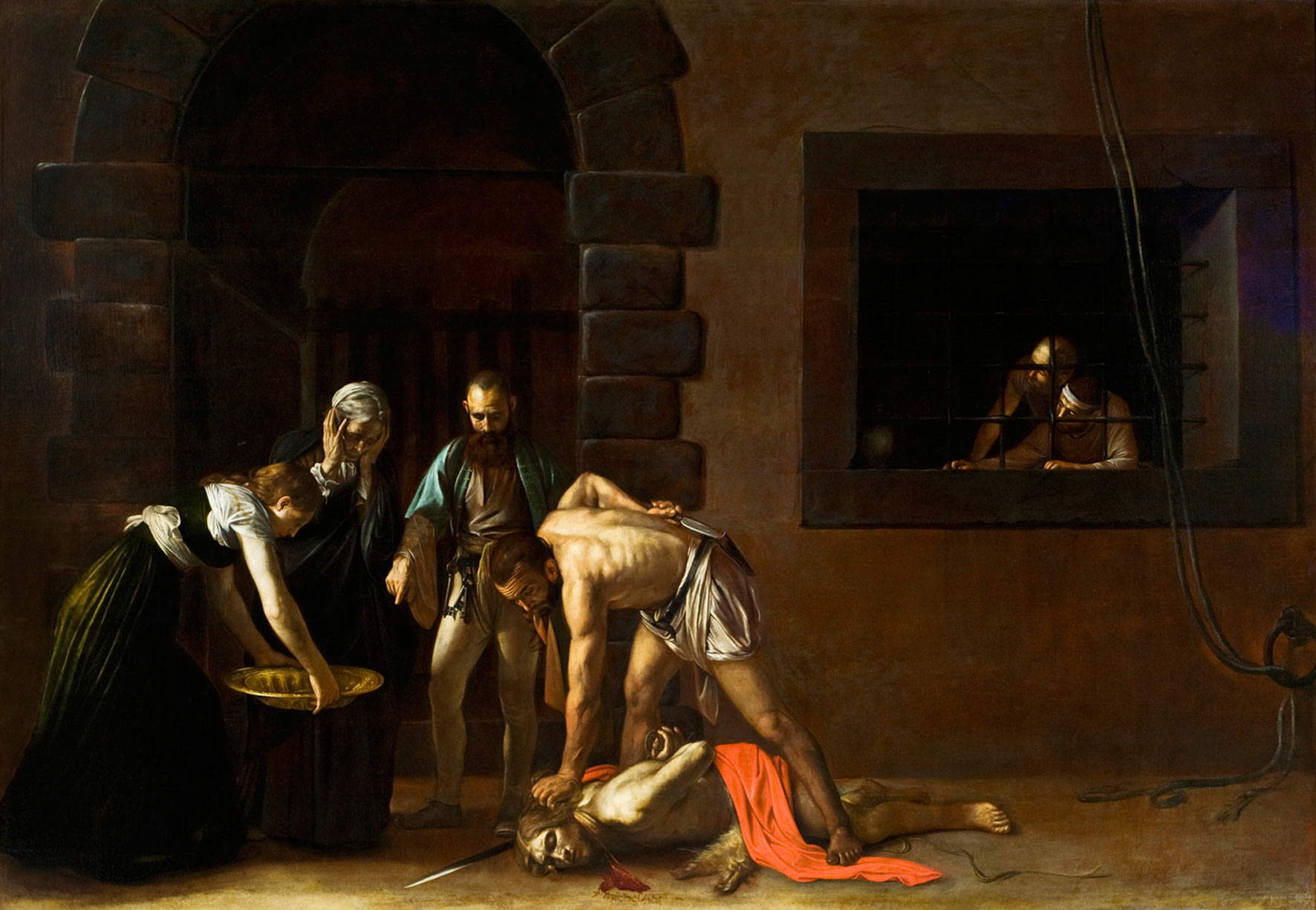 |
| Caravaggio, Beheading of the Baptist (1608; oil on canvas, 361 x 520 cm; Valletta, Co-Cathedral of St. John) |
For the Knights of Malta, Caravaggio began to paint his most impressive canvas, measuring about three and a half meters high by five and twenty meters wide. The scene takes place inside what appears to be a prison: four characters stand on the left side of the composition, one is the torturer who has just killed St. John the Baptist and who, with mercy, that is, the short dagger used to finish off a mortally wounded opponent, is about to take off the martyr, and the others stand around him (the jailer who, impassive, peremptorily points to the basin that is being supported by a young woman, probably Salome herself, but because of the very plain dress some have also suggested it is simply a servant girl, while the third character, an old attendant, brings her hands to her face in horror). Two prisoners, on the right side, observe the event from behind the bars of their cell. Bellori’s biographer describes the painting as follows: “For the Church of St. John had him paint the decollatione of the Saint fallen à terra, while the Executioner, as if he had not struck him at the first with his sword, takes the knife from his side, grasping it in his hair to detach his head from his torso. He looks intently at Herodiad et an old woman seco in horror at the spectacle, while the Keeper of the Prison in Turkish garb, points to the atrocious havoc. In this work Caravaggio used every power of his brush having worked on it with such fierceness, that he left the imprimitura of the canvas in half-tears.”
Underscoring the drama at work is the evocative power of the light, which a great scholar such as Maurizio Calvesi described as “jolting” and capable of recalling “the last throb of life in the body of the martyr who has fallen choking, with his hands tied behind his back.” Calvesi himself insisted on the portentous Caravaggesque direction, capable of constructing an effective narrative from every single element of the composition, including the iron ring driven into the wall on the right side, which “hints at what may have happened just before, when the saint was untied from that corner and dragged forward.” And then again, in the upper half of the painting, as is often the case in the paintings of the last Caravaggio, there are no living presences: all occupied by the large prison archway, the frame of the cell, the wall. That emptiness, which characterizes many of the paintings of the extreme phases of Caravaggio’s career, achieves here an amplitude hitherto never experienced (indeed: in this painting, for the first time architecture becomes co-protagonist), to modify the relationship between space and figure by giving more space to that “mute penumbra that dramatizes Titian’s tonal drafts in a suspended and recessed modulation.”
The theme of the beheaded saint, moreover a recurring one in Caravaggio’s later years, has given rise to various psychological readings of the work, facilitated also by the fact that the painter chose to write his signature in the blood of St. John the Baptist, as if to find a kind of identification with the martyr, since he too would have suffered the same end, given the death sentence that hung (literally) on his head. Certainly, there is discomfort in Caravaggio’s work away from Rome, and the bloody signature itself, wrote Paolo Jorio and Rossella Vodret, “added a darkly biographical trait” to the painting executed for Wignacourt. But to frame the work more correctly, it is necessary to read it in context: meanwhile, the need for a more intense and incisive realism was a need felt by the ecclesiastical authorities of the time, who went so far as to provide painters with precise prescriptions on how to set up religious images, which after the Council of Trent would be endowed with an important psychagogical function capable of inspiring pious sentiments in the faithful, who were obliged, if not to identify with what they observed in the works, at least to participate with lively and sincere contrition in the pain and sufferings of the saints. And in this sense, the Beheading of the Baptist is a work not so far removed from this way of understanding art, if we consider (as many scholars have moreover noted) that Cardinal Federico Borromeo, years later, in his treatise De pictura sacra (published in 1624, but summarizing indications that the clergy had already been giving for some time), recommended that artists should “portray the gloomy and horrid prison” in which St. John the Baptist was murdered, so that the focus would be on the saint’s martyrdom and not on other details, such as “the mother or the dastardly damsel who demanded John’s noble and venerable head.”
But Caravaggio, with the Malta masterpiece, went even further, imagining for the subject atotal identification, which passed through the very place for which the painting was intended. This is an intent that we are no longer given to appreciate today, since the renovation work on the Oratory of St. John the Baptist, undertaken beginning in 1680 with Mattia Preti, altered the original setting. The original arrangement of the oratory (and of Caravaggio’s painting) is known to us thanks to an engraving by the German Wolfgang Kilian (Augsburg, 1581 - 1662), who never went to Malta and therefore based his description on third-party sources, but who made the only image known to us of the oratory before the late 17th-century renovations. The painting thus closed the back wall of the worship building, and its measurements almost matched those of the wall, but not only that: the light, in the painting, was calibrated to appear as the natural light of the room. Jorio and Vodret again therefore speculate that Caravaggio wanted to give the painting an interesting illusionistic effect: “The scene,” they write, “seemed to place itself as the continuation of the space of the oratory because Caravaggio made the measurements of the canvas coincide with those of the back wall and used the direction of the light coming from the original windows. The boundary of the wall was thus completely annulled and the dark oratory had magically been transformed into an evocative theater: the viewer took direct part in the dramatic event at the very moment it happened, and the decolation was painted with such realism that, looking at it in the half-light, one could hardly believe it was the fiction of a painting.”
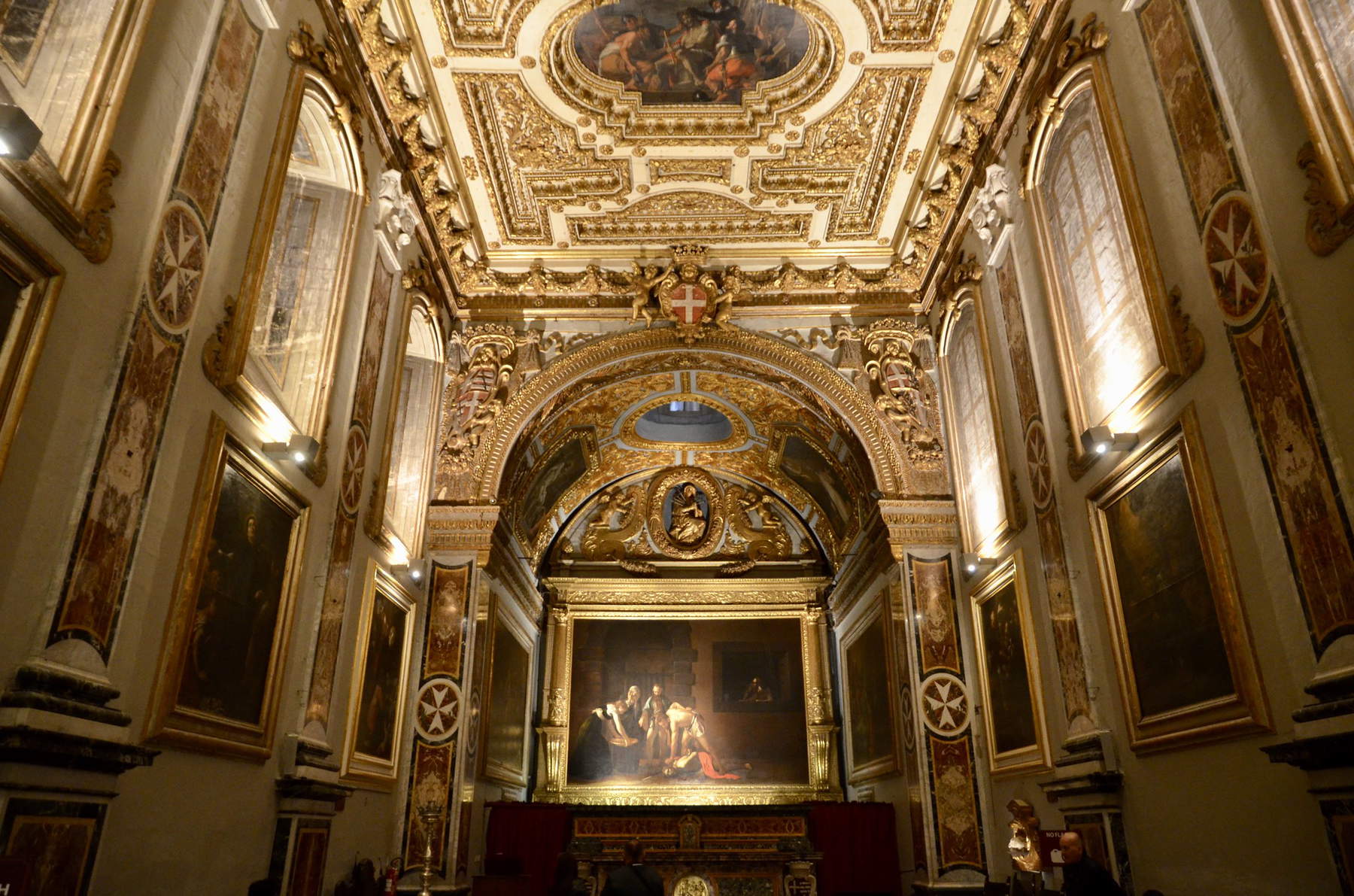 |
| Oratory of St. John Decollate. Ph. Credit Michael Jones |
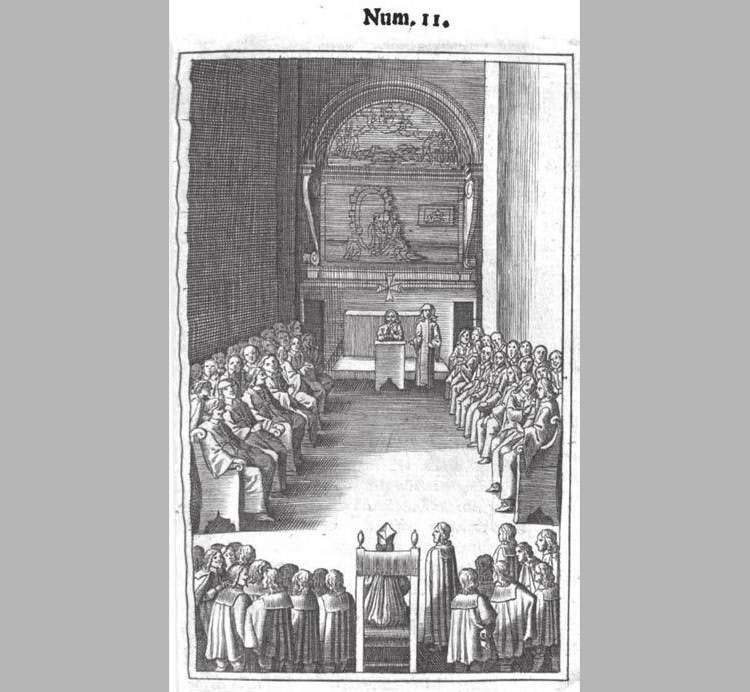 |
| Wolfgang Kilian, Oratorio di San Giovanni Decollato (C. von Osterhausen, Eigentlicher vnd gruendlicher Bericht dessen..., Augsburg 1650) |
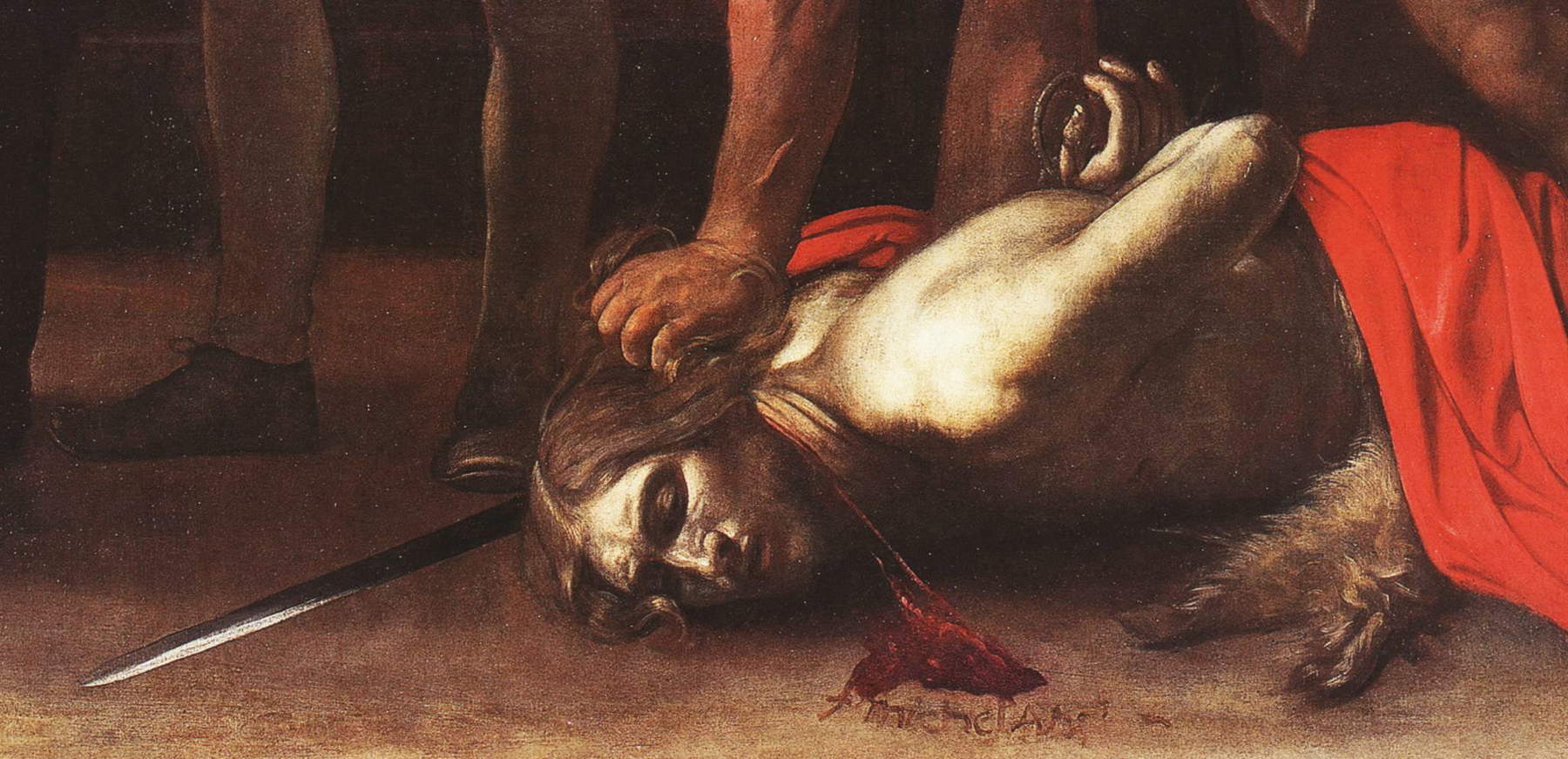 |
| Caravaggio, Beheading of the Baptist, detail of the Baptist with Caravaggio’s signature) |
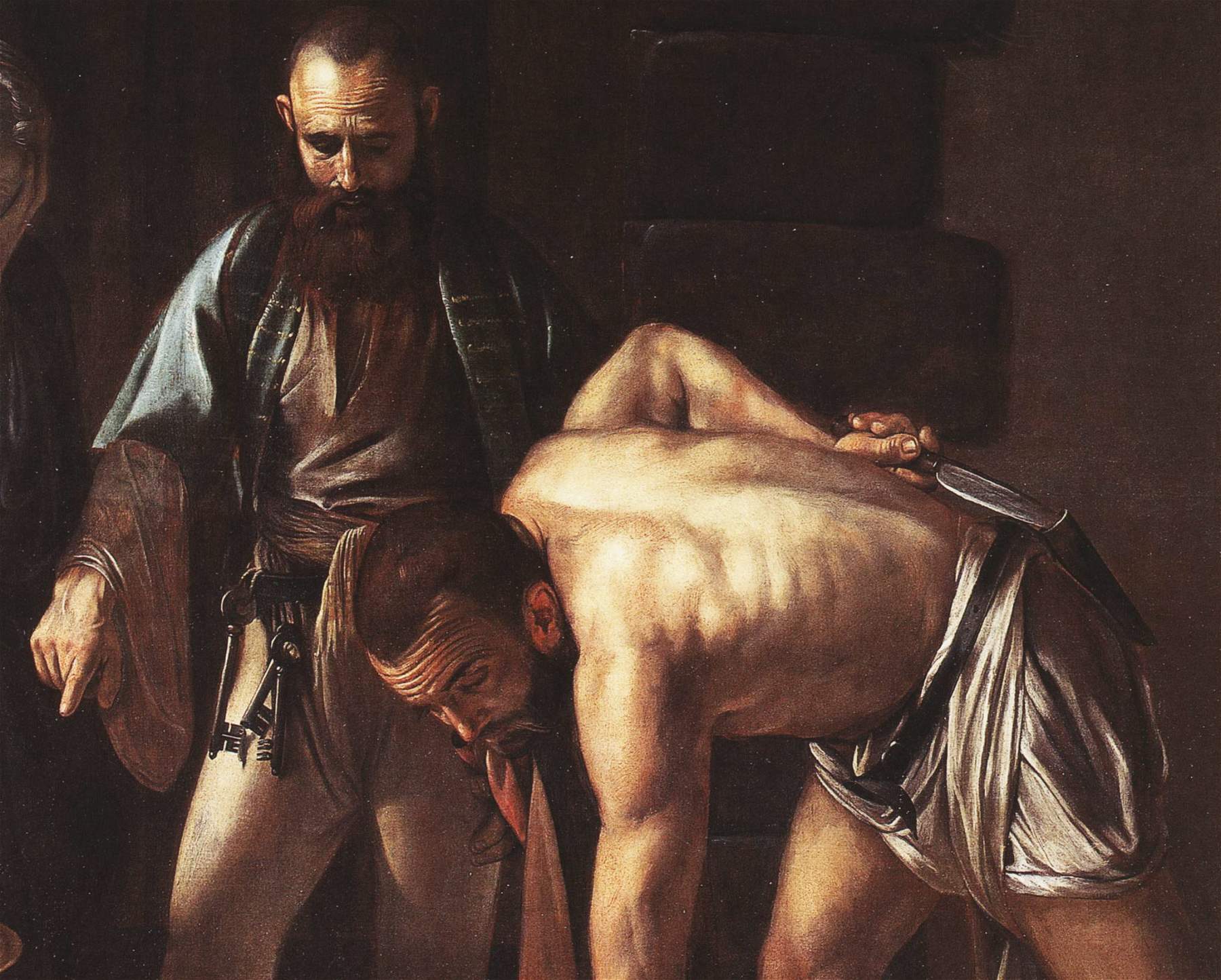 |
| Caravaggio, Beheading of the Baptist, detail of the torturer and jailer |
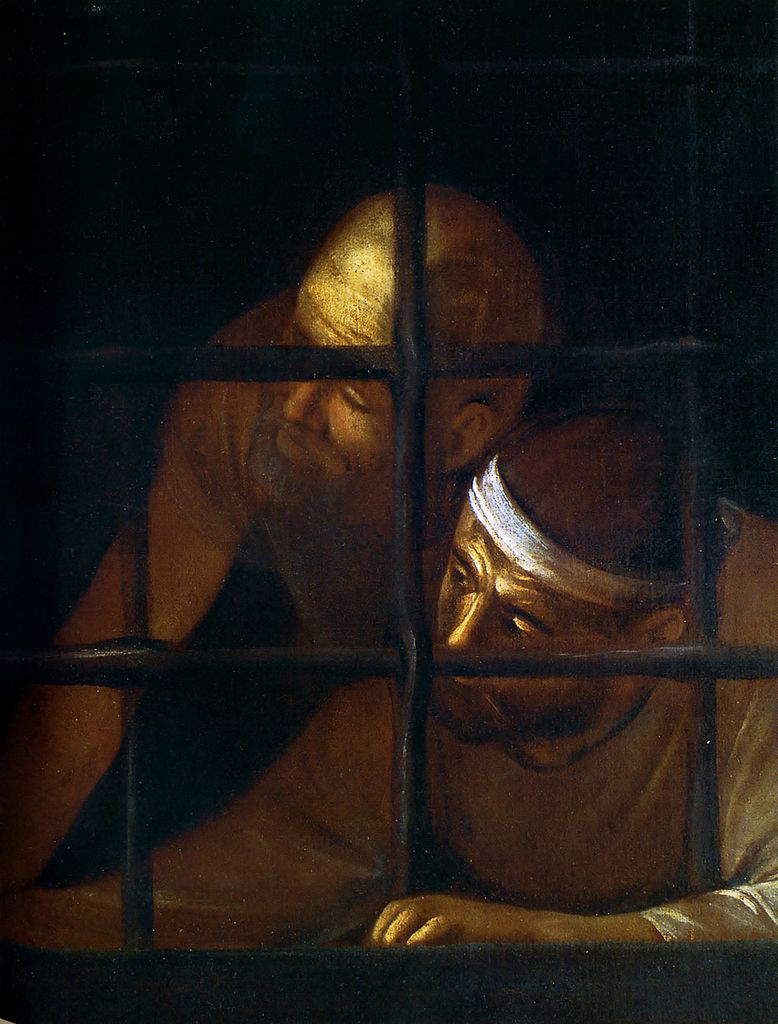 |
| Caravaggio, Beheading of the Baptist, detail of the two jailers |
The painting was then meant to serve precise “didactic” purposes, in line with the religious principles of the Knights of Malta: this feature of the Beheading has been well highlighted by scholar David M. Stone, who started from the observation that the presence of the two prisoners witnessing the scene is not a mere descriptive note, but takes the form, if anything, of a precise quotation taken from an engraving that illustrated Statute XVII of the Statuta hospitalis Hierusalem, the book, published in 1588, that collected all the rules of the Knights of Malta, which remained in use until 1609 and was well known even outside Malta. Statute XVII was about “prohibitions and punishments,” and Thomassin’s print, Stone writes, “sets up a dichotomy that no knight can misunderstand,” since on the right appear two free knights who are therefore following the path of virtue, and on the left, behind bars, their brethren who have committed errors. In the center, however, is the depiction of the terrible punishment that befell knights who were guilty of murder: the culprit was locked alive inside a sack and then thrown overboard from a boat. Indeed, it should be remembered that the Oratory of St. John the Baptist was, as mentioned, not only a religious place: it served as a court, but also as a place where assemblies were held in which important measures for the life of the Order were decided. Consequently, the decorative apparatus of the building was also meant, scholars Sante Guido, Giuseppe Mantella have pointed out, “to accompany, with the suggestion of images, the path of formation of the novices and the daily renewal of the promise by the professed brethren.” In this sense should be read, for example, the presence of a lunette depicting theIntercession of the Baptist to the Virgin for the knights who fell in the Great Siege executed by the Greek painter Bartholomew Garagona and which in ancient times overlooked the Decollation, and also the very presence of the image of the martyrdom of the saint who, Stone wrote, as the “forerunner saint,” is depicted as “the sacrificial lamb slaughtered for his faith” (and his martyrdom was thus to be read in parallel with the martyrdom of the fallen knights during the Great Siege).
Finally, is it possible to trace any figurative sources that Caravaggio might have remembered in executing the Maltese painting? Of course, we cannot know for sure what memories Caravaggio held at the time of the making of the Maltese painting, but several scholars have tried to advance possible analogies: for example, Bernard Berenson has noted how the calibrated severity of the composition recalls Andrea del Sarto ’s The Beheading of the Baptist (Andrea d’Agnolo Vannucchi; Florence, 1486 - 1530) at the Scalzo cloister, where moreover the saint is in the same pose as he is in Merisi’s painting. And again, Roberto Longhi evoked two paintings by Antonio Campi (Cremona, 1522 - 1587), which were in Milan and which Caravaggio certainly knew: these are The Beheading of the Baptist preserved in the church of San Paolo Converso and Saint Catherine Visited in Prison by the Empress Faustina, which is instead in Santa Maria degli Angeli. In particular, the second painting was for Longhi a “luminous machine” from which Caravaggio showed that he “drew his pro,” and not so much for the setting of the luministic effects (Caravaggio, compared to Campi, is already an artist of a later period), as for the layout of the scene, with the cell grating on the right balancing the characters on the left and the gloomy void in the upper register. Another artist often called upon for the Beheading is Moretto (Alessandro Bonvicini; Rovato, 1498 - Brescia, 1554), especially because of the presence of the realistic architecture that constitutes one of the typical elements of the Brescian painter’s art, certainly familiar to Caravaggio. And then, from Lombard art is also inferred the idea of signing with blood, which is not a Caravaggesque invention, but is an idea already present for a long time in similar works by artists active in Lombardy: for example, in a work by Moretto himself, the Martyrdom of St. Peter Martyr, an identical solution is found (here, the blood on the ground forms the word “I believe”).
 |
| Philippe Thomassin, De prohibitionibus et poenis, illustration for Statute XVIII of the Statuta hospitalis Hierusalem (engraving, 183 x 138 mm; Washington, Catholic University of America) |
 |
| Andrea del Sarto, Beheading of the Baptist (1523; fresco; Florence, Chiostro dello Scalzo) |
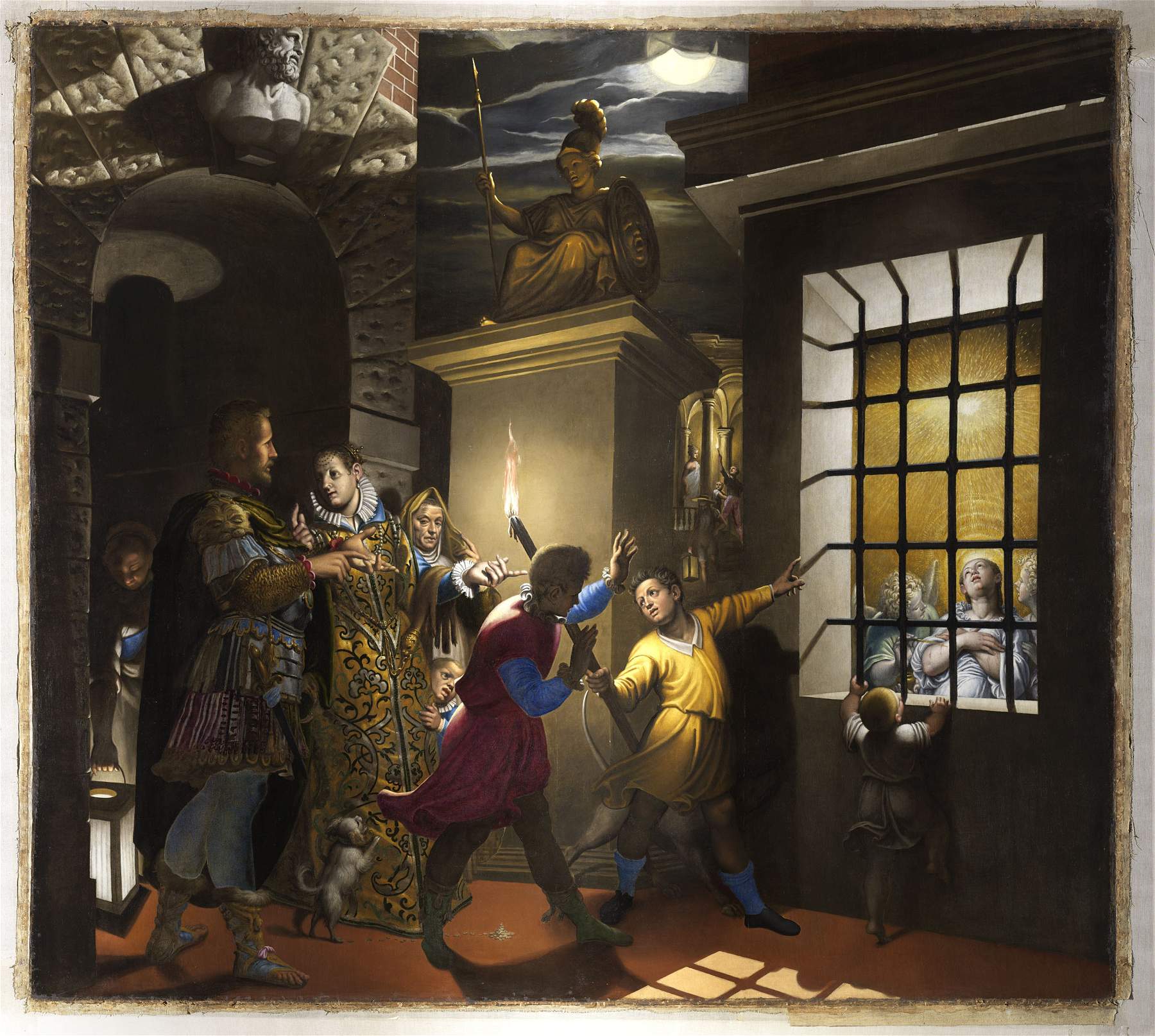 |
| Antonio Campi, Saint Catherine Visited in Prison by the Empress Faustina (1584; oil on canvas, 400 x 500 cm; Milan, church of santa Maria degli Angeli) |
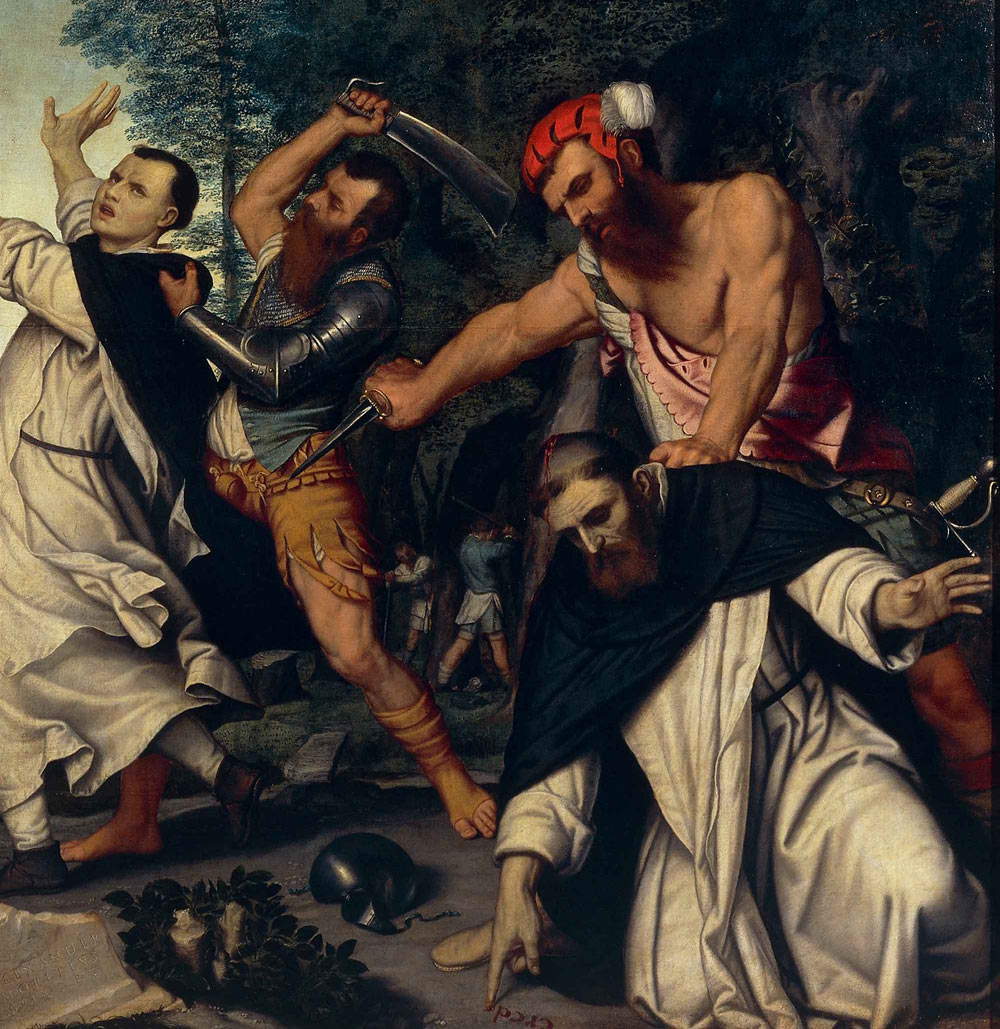 |
| Moretto, Martyrdom of Saint Peter Martyr, detail (c. 1533-1534; oil on canvas, 310 x 163 cm; Milan, Pinacoteca Ambrosiana) |
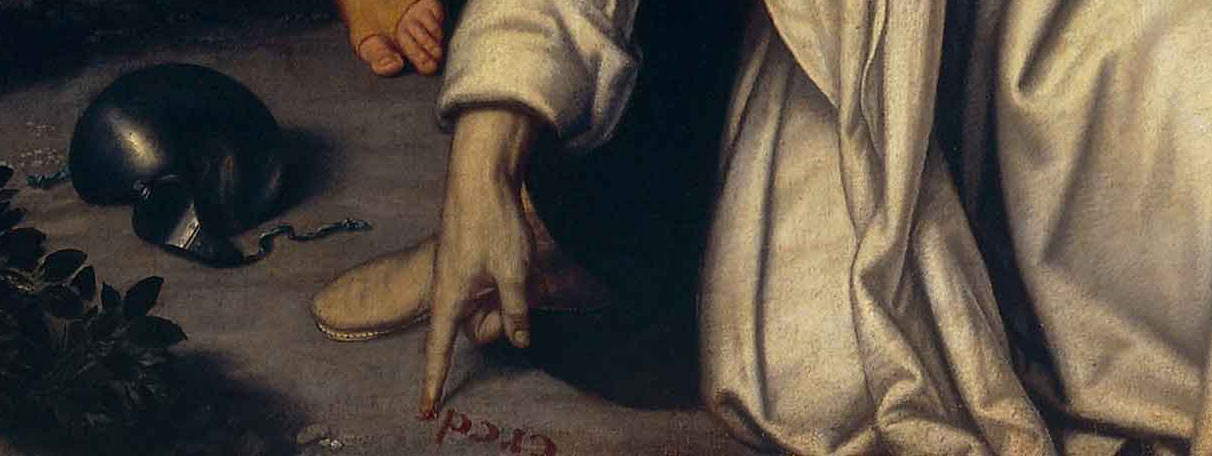 |
| Moretto, Martyrdom of Saint Peter Martyr, detail (c. 1533-1534; oil on canvas, 310 x 163 cm; Milan, Pinacoteca Ambrosiana) |
There is then a further novelty worth dwelling on, namely the shift from an excited style that had characterized earlier convulsive scenes in Caravaggio’s art (think, for example, of the Martyrdom of St. Matthew in San Luigi dei Francesi, or even the Seven Works of Mercy in Naples) to a meditative style: a distinction underscored by Mina Gregori, according to whom, in the Beheading of Malta, Caravaggio opts for "a tragic concentration of only the dramatis personae“: ”a peremptory calm and solemn truth of feelings,“ writes the scholar, ”replace the echoes of ancient pathos. The stoic detachment with which Caravaggio narrates the event is insensibly transformed into the modern eye that manfully and without illusions registers human destiny, so that it can be said that without this ’supreme masterpiece of European art’ [as Denys Sutton called it, nda] we would have neither Rembrandt nor theEnterrement à Ornans," the latter great masterpiece by Gustave Courbet now in the Musée d’Orsay. It is precisely a modern conception of the fact that Caravaggio introduces into the Valletta painting: from the concept of “action,” dynamic and caught in its temporal dimension, in its passage from one moment to another, Michelangelo Merisi substitutes, notes Mina Gregori, thehic et nunc, “the actuality of the fact and a new, modern reification.” A modernity that had led Denis Mahon to speak of "brand new impressionism" for the style of the last Caravaggio.
However, the artist did not have time to enjoy the fruits of his labor. It has already been mentioned that, on July 14, 1608, the artist was knighted, and for his painting the artist also received two slaves as gifts. But that was not all: his success won him other commissions, starting with the St. Jerome, also preserved in Malta, which was commissioned by Ippolito Malaspina (Fosdinovo, 1540 - Malta, 1625), a knight from Lunigiana who was among the painter’s most trusted friends at the time of his brief stay on the island. However, the brief happy period was harshly broken by the brawl on August 18, during which the aforementioned Giovanni Rodomonte Roero was injured: the following day, the Grand Master ordered an inquiry to be opened to shed light on the incident, and Caravaggio’s guilt eventually emerged. Then, the escape on October 6 and, finally, when Caravaggio was already far away and safe in Sicily, the sad ceremony of privatio habitus, or the “deprivation of the robe”: one therefore wonders how the story would have turned out, and how many more masterpieces the great painter could have painted, if only he had not been involved in yet another trouble. The reality, however, turned out differently: on December 1, 1608, the Knights of Malta formally expelled him from the Order, declaring him a “membrum putridum et foetidum,” “putrid and fetid member.” And the sentence was read right in front of that Decollation that the artist had delivered only a few months earlier.
The two works by Caravaggio mentioned in the article, namely the Beheading of St. John the Baptist and the Writing St. Jerome can still be seen today inside the Co-Cathedral of St. John: the official website has admission times and information on tickets for access. Valletta, the capital of Malta, is a UNESCO World Heritage city, is rich in art and culture, and is a prime starting point for discovering the entire Maltese archipelago and its centuries of history.
Essential Bibliography
Warning: the translation into English of the original Italian article was created using automatic tools. We undertake to review all articles, but we do not guarantee the total absence of inaccuracies in the translation due to the program. You can find the original by clicking on the ITA button. If you find any mistake,please contact us.